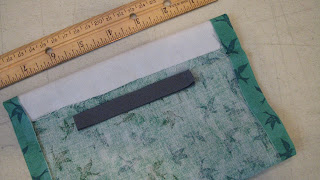It seems likely that masks are going to be part of our wardrobes for awhile. As soon as that became clear, I pulled out my faithful old Singer slant-needle machine & my stash of fabric and got started making these 3-layer cloth masks.
I've had requests for the pattern, so here it is in pictures with brief instructions - they're quite simple and I am sure that anyone who can sew will quickly master making their own. This pattern is for an average adult-sized mask - feel free to tweak the measurements to suit your needs. I will include notes at the end for the measurements for kid's masks.
Though I've known how to sew since I was quite young, I think like a leathercrafter when it comes to patterns and assembly. For example, you'll notice that I don't use pins - don't let that throw you. If you want to use pins as you go, please do!
My first masks were made with cotton pipe-cleaner-filled nose-bridge wires, which I've since replaced with aluminum strips bought online. Both work well, but if you're making a lot of masks, the precut strips with adhesive backs save quite a bit of time.
This collage shows my prep for these - both are encased in fabric which extends about 1/2" past the ends so it can be captured when you sew.
The aluminum strips get sandwiched inside a piece of bias tape. Quick and easy.
For the pipe-cleaners, fold two of them in half and nestle them together as shown. Then roll them inside a piece of your fabric, remembering to let the fabric extend past the wire ends on both sides.
In addition to the nose piece, you'll need a piece of cotton fabric measuring 12" x 9" and an inner layer measuring about 7.5" x 5.5". I've used a white interfacing material, but you can use any plain scraps you have around, such as sheet fabric.
I'm using 1/8" elastic cord - 1/4" is okay if you prefer ... you'll need two pieces per mask, each about 7" long.
Pins or two-sided tape, scissors, thread and you're ready to go!
Fold the larger piece of fabric in half, iron to create a crease, then refold with right sides together to form a 9" x 6" rectangle. Lay the smaller piece on this rectangle, roughly centering it.
Stitch a 3/8" seam along the bottom raw edge, catching the inner lining in the stitching.
Next, turn the end edges in about 1/2", overlapping the inner layer - press the edges in place.
Flip your project over to expose the unlined side, then center your nose piece snugly against the crease. Use a small piece of 2-sided tape (on the inside) or pins (on the outside) to hold this in place. Then turn the whole thing right-side-out and press flat.


Now Stitch around the edge, as close as you can to the edge, making sure to tuck about 1/2" of elastic into the corners as you go, one piece per end for the ear loops.
Stitch around the nose piece as shown.
Form 2 pleats, about 1/2" deep, and press into place. Pin if you like.
Stitch a line across the top under the nose piece, then stitch down the side, securing the pleats, then across the bottom and up the other side, finishing the pleats.
Viola! You've made a mask!
 Loop the elastics around your ears & expand the pleats to cover your chin & nose. Press the nose piece to form a comfortable fit.
Loop the elastics around your ears & expand the pleats to cover your chin & nose. Press the nose piece to form a comfortable fit.
These can be washed in warm water with your favorite detergent and dried on medium heat. Straighten the nose wire after laundering, as needed. Can be ironed on a cotton setting if desired, but take care not to overheat the elastic or the nose wire.
For masks to fit kids between ages 4-10, the instructions above will work, but your main piece will be about 8.5" x 7.5", inner piece about 4" x 6", with elastic pieces about 6".
Kid's masks need just one pleat, centered in the middle.
Permission granted to all to use this pattern freely - pass it on!
*These are not medical-grade masks*





























